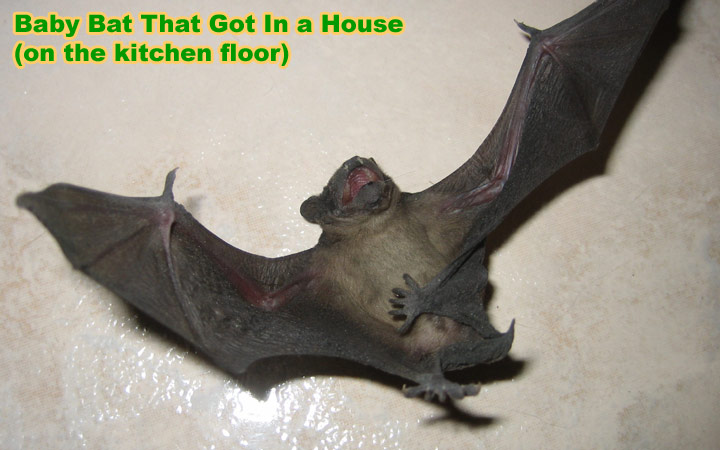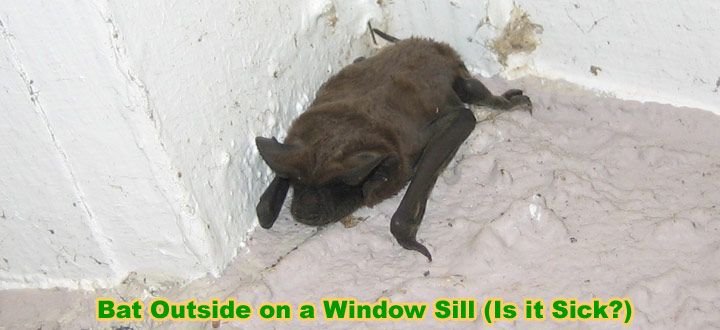|
|
What to do with a baby bat I found?
To find a bat rehabber in your area, click on my nationwide directory of wildlife rehabbers or do an online search for one in your area. In the meantime, you can still care for the bat as advised below.
Yikes! A Baby Bat!
First, in many areas of the country, bats are known carriers of rabies. Rabies is a virus that can be transmitted to any mammal from any other mammal by way of contact with saliva and bodily fluids. Rabies is always fatal. Before handling a bat, always wear gloves. If you’ve found an adult bat with an injury, that animal needs to get into professional hands as soon as possible. This is especially true if a cat has gotten ahold of the bat. Bacteria in a cat’s saliva can cause sudden, severe infection in small critters. Without professional intervention, that bat will die from a cat bite.
Baby bats are often discovered after a homeowner has taken it upon themselves to eliminate a bat infestation. With the adult bats removed, homeowners often don’t think about the babies. A day or so later, the little bats are discovered causing a ruckus in the attic.

I received an email from batworld.org, and they stated that my information on this page isn't accurate. Below is what they had to say:
I came across your website about raising baby bats after someone contacted us saying they had used the directions on your site. Sadly the baby did not survive, likely because this person took matters into her own hands rather than contacting someone trained and vaccinated. A lot of folks are probably finding your page and using the information to try to care for bats when they should be transferring the bats to a rescuer. I think we both have the same goal in mind, which is helping bats, but unfortunately the information on your site is actually causing harm. I am hoping that you will consider incorporating or deleting the following for the reasons given.
1. You mention that people often find bat babies after they have dealt with an infestation, however, it is illegal in most states to exclude bats during baby season. They way the site is worded folks may think it's perfectly fine to exclude bats, or even seal bats in, during baby season, which of course will result in the deaths of hundreds to thousands of bats.
2. Placing a heating pad underneath a box will roast bats alive who are unable to move off the heat. This includes babies as well as injured adults.
3. Bats cannot be hydrated by oral fluids alone because their metabolism is too high. They must receive subcutaneous injections of electrolytes before being offered food. Critically dehydrated bats who are not hydrated by injection before being fed will die a painful death from organ failure.
4. Not all baby bats need to be stimulated to go to the bathroom. Stimulating some species causes undue stress which will lead to a pup refusing to eat.
5. Bristles are not recommended for 99% of bat pups because they won't accept them. Additionally, bats can break the bristles off with their milk teeth and possibly choke. The bristles will also cause air to be swallowed resulting in painful, and often deadly, bloat.
6. Goats milk is not a comparable replacement. The milk also needs to include a particular oil for essential fatty acids chains, human baby powder formula of a specific brand, and egg white powder depending on the species. Additionally, tree bats absolutely cannot tolerate goats milk and it will kill these pups. These bats need a completely different type of milk formula in order to survive.
7. If bats are not held correctly and fed in the proper position and with the correct instrument according to the species, they will aspirate and die.
8. Mealworms are introduced at 6 to 8 weeks, not 2 at 3 weeks. At 2 to 3 weeks bats are still very much babies.
The biggest issue with all of the information provided on your page is the potential for someone to attempt to care for a bat who is incubating rabies and then become bitten and contract rabies in the process. Even baby bats (who have milk teeth) can transmit rabies. This scenario has the potential to do an incredible amount harm to bats nationwide. We go to great lengths on our page to tell folks how to save bats safely and get them to a rehabber asap. You are welcome to copy any of the information on this page if you'd like: batworld.org/what-to-do-if-you-found_a_bat/
The Old Info I Published:
Shouldn’t we leave the baby bat for the mother to find? This is a good idea if you’ve discovered the baby bat in the woods; however if this bat is from your home, you’ll want to consider the advice of a professional wildlife remover as well as a rehabilitator. If the baby bat is found out in the forest, you can attempt to replace the bat in or near the roost. A truly orphaned bat from a recently evacuated attic needs to be cared for in the same style as other orphaned mammals.
Using a container with high sides, pad the bottom with easily cleaned material placed over top of a warm bottle or heating pad. Temperature is very important. Most young bats cannot regulate their own temperatures.
Always assume there is some level of dehydration present in a baby mammal. Until your wildlife rehabilitator arrives, you can try to administer an oral electrolyte supplement such as human Pedialyte. There are veterinary electrolyte supplements on the market, but most of us don’t have these readily accessible in our homes. Holding the baby bat vertical in a towel, careful not to damage the wings, you can administer the liquid with a tiny feeding syringe.
If you’re feeding the baby bat, you’re going to need to encourage it to go to the bathroom after every meal. This task must be done or the baby will die from a build-up of waste. Using a warm, moist Q-tip, gently rub the abdomen area and the rectum. After a few moments, you will see urine and stool emerge onto the Q-tip. This must be done for the initial two to three weeks.
Liquid Feeding Tip: If you don’t have the small feeding syringe required for very tiny newborns, you can use a fine paintbrush to administer tiny drops for the animal to suck off the bristles. You have to use caution with any mammal that has a nose in close proximity to the mouth. Aspiration, the delivery of fluid into the lungs, can be deadly. You can tell if the baby has aspirated by the appearance of a fluid bubble out of the nostril.
When the wildlife rehabilitator takes over care of the orphaned baby bat, rehydration will be completed and then formula feeding introduced. Goat’s milk replacer is a comparable replacement for bat’s milk. The rehabilitator will feed the bat between every one to three hours depending on the bat’s size and species.
Between two to three weeks, the bat will be graduated from formula to mealworms. This transition will happen gradually, with the mashed mealworms being offered in a formula mixture. By the end of three weeks, the bat should be eating mealworms whole.
There is some debate about releasing hand-raised bats back into the wild. Bats learn hunting skills and roosting skills from other bats in a community. These skills are not easily replicated in a rehabilitation setting. Some bats can be taught to catch insects while flying in a large enclosure, which makes release back into the wild feasible. Rehabilitators have found some limited success in creating bat colonies out of the bats in their own rehabilitation centers and then releasing them all together.

What if you find an adult bat lying around? When this happens, it's because there's a problem, of course. A healthy bat will be roosting, high off the ground, and hard to find. If a bat is lying on the ground or a building somewhere, then there's a good
chance that it's sick. So if you do handle it, do so with extreme care! Thick gloves, and then never even touch the bat directly. It could just be injured or in a stupor, but it could also be rabid. You can take such bats to a rehabber.
Due to the concerns regarding hand-raised bats, it is always in the animal’s best interest to get it to a wildlife rehabilitator as soon as possible. Because these experts operate from their personal finances, we encourage you to donate if you have the need to use a rehabilitator’s facilities.
Here are some other advice articles for wildlife rehabilitation:
What to do with a baby bat I found?
What to do with a baby deer I found?
What to do with a baby fox I found?
What to do with a baby opossum I found?
What to do with a baby raccoon I found?
What to do with a baby hawk or eagle I found?
What to do with a baby reptile I found?
What to do with a baby mouse or rat I found?
What to do with a baby songbird I found?
What to do with a baby squirrel I found?
|
|
 |
Please be kind to wildlife! Our wild animals are intelligent, and believe it or not, they definitely have emotions! |
 |
|
|
|